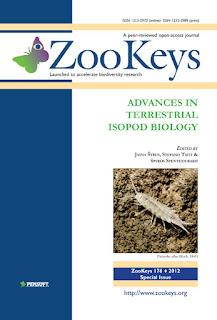Terrestrial isopods (woodlice) are the only group of crustaceans fully adapted to life on land and with about 3,700 species known at present represent the largest suborder of Isopoda. They occur in almost any kind of terrestrial habitat, from littoral to high mountains, from forests to deserts, with some species adapted to live in subterranean environments and others secondarily having returned to water. Woodlice are particularly important from a biogeographical and an ecological point of view, since they have limited dispersal ability, are often endemic to small geographic areas, and are extremely diverse ecologically.
They also represent en excellent model group of animals to study the physiological adaptations related to the transition from an aquatic to a terrestrial way of life. This special issue of ZooKeys includes a collection of 20 papers presented during the 8th International Symposium on Terrestrial Isopod Biology, which was held at Bled, Slovenia from 19th to 23rd June 2011. Contributions address a wide range of topics related to terrestrial isopods, such as systematics, biogeography, morphology, physiology, molecular biology, microbiology, and ecology. Two contributions are related to the state of the art and future perspectives on biomineralizations in crustaceans and ecotoxicology in soil fauna. This special issue will be of great value for anyone interested in the biology of crustaceans in general and of terrestrial isopods in particular, stimulating future research on this unique group of animals.
- Author: Jasna ?trus, Stefano Taiti, Spyros Sfenthourakis
- Publisher: PenSoft Publishers LTD
- Published: Mar 20, 2012
- Language: English
- Format: PDF
- Pages: 296
- Link: Advances in Terrestrial Isopod Biology

About author: Author Name
Cress arugula peanut tigernut wattle seed kombu parsnip. Lotus root mung bean arugula tigernut horseradish endive yarrow gourd. Radicchio cress avocado garlic quandong collard greens.


0 comments:
Post a Comment